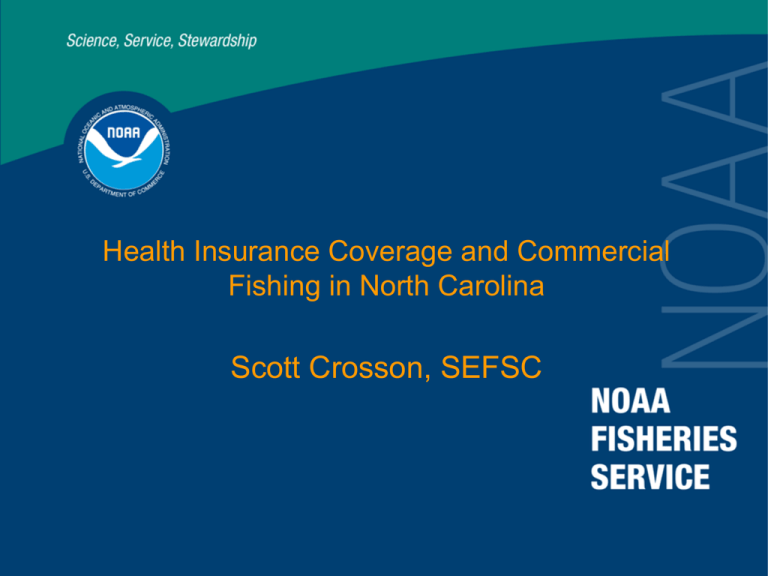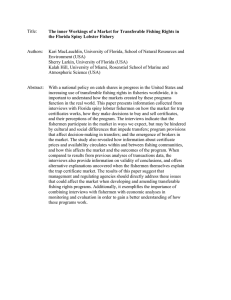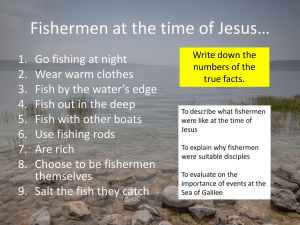Scott Crosson, SEFSC Health Insurance Coverage and Commercial Fishing in North Carolina
advertisement

Health Insurance Coverage and Commercial Fishing in North Carolina Scott Crosson, SEFSC Previous works from this data set: Crosson, S. 2015. Anticipating exit from North Carolina's commercial fisheries. Society & Natural Resources. Forthcoming. Crosson, S. 2011. Resistance to Alternative Management in Fisheries: Economic and Cultural Considerations of North Carolina's Commercial fishers. Politics and the Life Sciences 30 (2): 31-42. Methods Data from two sequential surveys conducted by the North Carolina Division of Marine Fisheries (DMF) + trip ticket totals 319 completed surveys, right before ACA passage 149 from inland-working fishermen (2010) 170 from ocean-working fishermen (2009) “Do you have health insurance?” (binary) if yes, “Who pays for it?” (self, other job, spouse plan, other) If commercial fishing is the most dangerous profession (Janocha 2012), then … Are fishermen working in more dangerous areas and/or with more dangerous gear more likely to purchase health insurance? Are fishermen with more to lose (higher fishing incomes, more capital wrapped up in gear) more likely to purchase health insurance? Assumption: fishermen would use the formula RISK = PROBABILITY * CONSEQUENCE (Windle et al 2008) to assess the potential impacts of job-related injuries with and without health insurance coverage and make the tradeoffs of out-of-pocket costs vs potential benefits. Increased probability: areas Areas are the Atlantic Ocean or inland southern district (very nearshore). Increased probability: gears Four most common gear types among respondents: crab pots, shrimp trawls, gill nets, and rod & reels. Southern inshore district Atlantic Ocean off North Carolina Gear risks: Thomas et al (2001): injuries were generally from falls on deck, entanglement in machinery, or being struck by an object (AK) Marshall et al (2004): penetrating wounds from sea life & strained backs are common among NC commercial fishermen Kucera et al (2010): injuries caused by knives, hooks, & other sharp objects are common among NC commercial fishermen More on gears: Lipscomb et al (2004): rod & reel have the highest injury rates among NC gears Kucera et al (2009): significant lower back pain from the use of net reels and trap pulls, along with sorting the catch on board. Increased consequences: lost catch Catch value year of survey Increased consequences: capital not being used $$ tied up on gear and boats Possible conflating variables Age, as the overwhelming majority (78%) of fishermen who chose “other” as a source of coverage were age 65 or older and hence covered by Medicare Household income expected to be positively associated with coverage Marriage could make purchasing insurance unnecessary Results Fishermen working in the Atlantic Ocean environ were significantly more likely to have health insurance coverage (79%) than those working in the inland waterways (55%) (p<. 001) Difference is DESPITE higher age of inland fishermen (55) vs ocean fishermen (49) which means more are Medicare eligible. Inland fishermen were much more likely to note that they had health coverage provided from the “other category” (27%) than the ocean fishermen (7%) (p<.001). But are they purchasing it out of pocket? But are they purchasing it out of pocket? Higher coverage rates of ocean-working fishermen is at least partially due to their choice to purchase health insurance on the market at much higher rates (40%) than inland fishermen (11.4%) (p<.001). But are they purchasing it out of pocket? Higher coverage rates of ocean-working fishermen is at least partially due to their choice to purchase health insurance on the market at much higher rates (40%) than inland fishermen (11.4%) (p<.001). This suggests that fishermen working in ocean waters recognize their greater risk and are choosing to mitigate it by purchasing insurance. Probit regression for the binary DV purchased own health insurance. Primary drivers of purchasing health coverage are ocean fishing and a number of economic factors such as fishing business size, capital investment, and education. Supports findings that working in the ocean causes higher injury rates due to fatigue (Jin et al 2001, Matheson et al 2001, Kurcera et al 2010) Fishermen with higher fishing incomes and capital investments have more to lose from the consequences of injury (Smith and Wilen 2005) Only gear choice that appears to be a factor is rod & reel, but negative? contrasts with Libscomb et al (2004) that found finfishing to be the highest injury-causing mode of commercial fishing in North Carolina due to repetitive baiting Being a commercial fishermen is a risk factor for not having health coverage at all (Swartz et al 1993) Commercial fishermen have often been ineligible to purchase many plans due to the insurance industry’s perception of increased risk (Light et al 2001) Because the passage of the ACA has likely reduced those costs, it will be worthwhile to do a longitudinal follow up in the near future to see if purchasing decisions have shifted.






